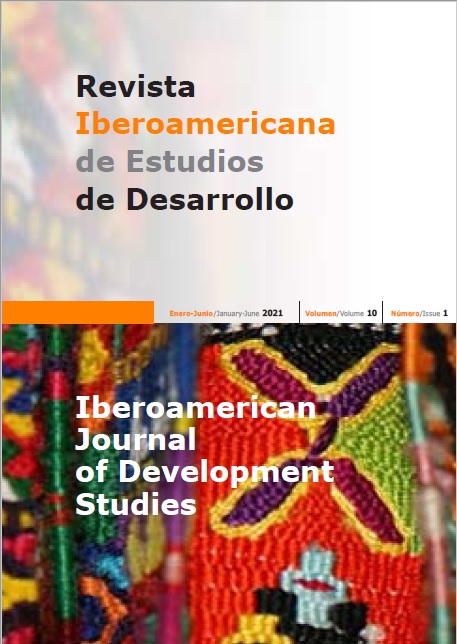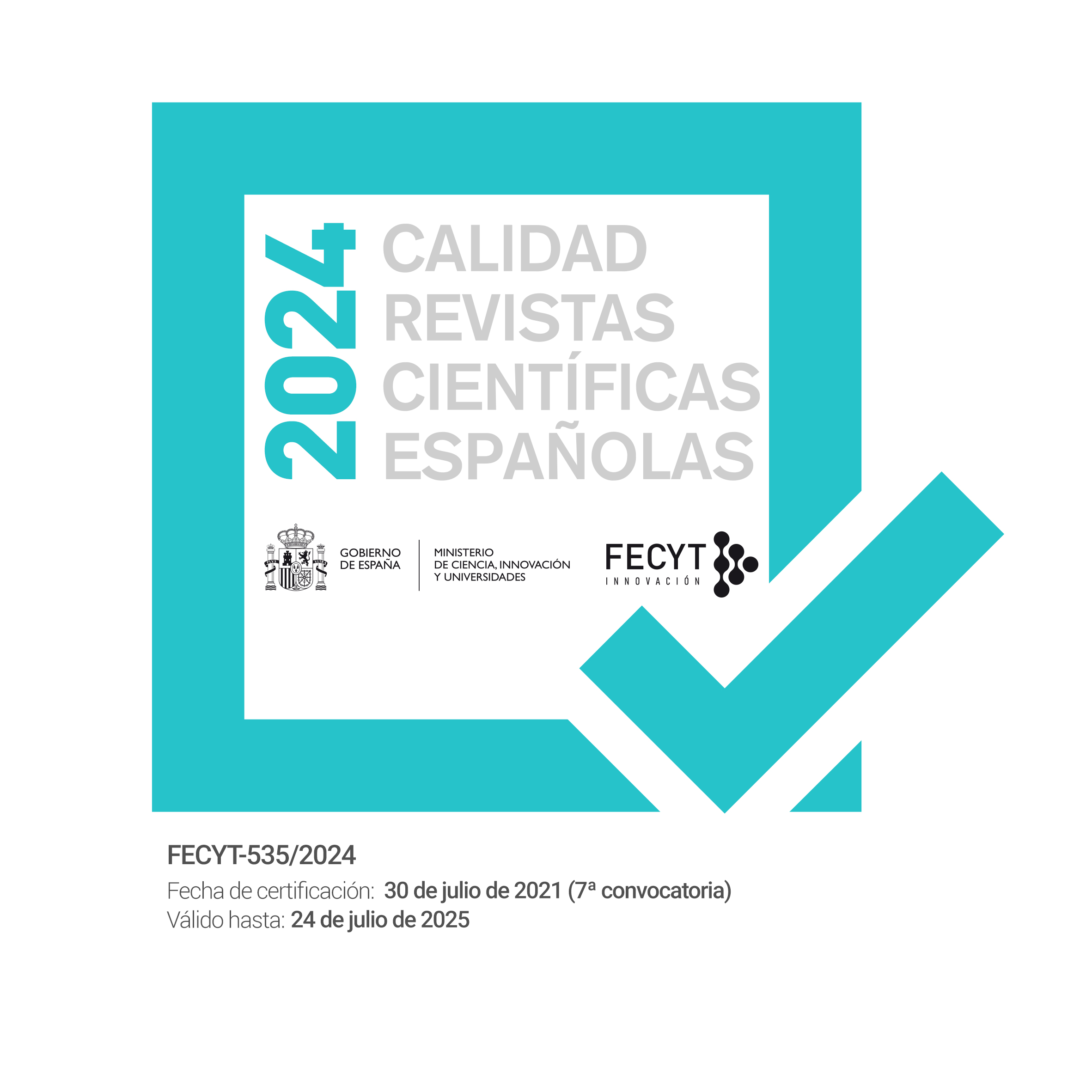«By the pricking of their thumbs»: farmers’ income dynamics towards sustainable development in rural Ethiopia
DOI:
https://doi.org/10.26754/ojs_ried/ijds.476Palabras clave:
agricultura, ingresos de los agricultores, investigación-acción, sustentatibilidad, EtiopíaResumen
Las prioridades de cooperación internacional y los objetivos de desarrollo sostenible coinciden
en el vínculo entre la agricultura y la economía en el progreso de los países en desarrollo hacia la
sostenibilidad. En las zonas rurales de Etiopía, la agricultura es la principal fuente de ingresos y medios de vida. En este estudio, se pretende analizar la asociación entre la experiencia de los agricultores, la educación, el género, el cultivo de la diversidad de cultivos, el acceso a diversos recursos financieros
y los niveles de ingresos entre las diferentes aldeas. La metodología adoptada es la investigaciónacción,
realizada durante varias estancias de investigación en zonas rurales de Etiopía, y utilizando encuestas cualitativas y cuantitativas. Los resultados cuantitativos se analizaron mediante análisis
estadístico multivariante. Surgen resultados interesados; por ejemplo, los agricultores de las aldeas
rurales que han estado utilizando pozos previamente donados por organizaciones sin ánimo de lucro
(OSAL) muestran varios impactos positivos. Asisten a capacitación continua en agricultura, nutrición
y economía; tienen más diversificación de cultivos, y utilizan recursos financieros variados. Todos
estos factores, así como las variables sociodemográficas, vinculan los niveles de ingresos de los
agricultores con la mejora y el empoderamiento de las aldeas, lo que crea desafíos significativos
para el diseño institucional de políticas alternativas para maximizar la subsistencia, la sostenibilidad
y el desarrollo socioeconómico de los agricultores en los países del Tercer Mundo. El artículo se suma
al muy pequeño cuerpo de investigación, particularmente de análisis cuantitativo, sobre factores
asociados con los ingresos de los agricultores en África basados en datos primarios.
Descargas
Referencias
ABRO ZA, ALEMU BA, HANJRA & MUNIR A (2014). Policies for agricultural productivity growth and poverty reduction in rural Ethiopia. World Development 59, 461-474. http://dx.doi.org/10.1016/j.worlddev.2014.01.033, accessed August 15, 2020.
AFRANE S (1997). Impact Assessment of Micro-Finance interventions in Ghana and South Africa. Journal of Micro-Finance 4(1):38-58.
ALEMU BA (2010). Rural poverty, land management practices and agricultural productivity in Ethiopia (Ph.D. dissertation). Justus-Liebig University of Giessen, Germany.
ANDERSON P, TUSHMAN M (1990). Technological Discontinuities and Dominant Designs: A Cyclical Model of Technological Change. Administrative Science Quarterly 35(4):604-633.
ARMENDÁRIZ B, MORDUCH J (2010). The Economics of Microfinance, Second edition. MIT Press, Cambridge (Massachusetts).
ARROW KJ (1962). The Economic Implications of Learning by Doing Author(s): Kenneth. The Review of Economic Studies 29(3):155-173.
ARTURO A, ELIANA C, MARKUS G, TALIP K, GBEMISOLA O (2014). Decomposition of gender differentials in agricultural productivity in Ethiopia. Policy Research working paper; no. WPS 6764. Washington, DC: World Bank Group. http://documents.worldbank.org/curated/en/726871468252571077/Decomposition-of-gender-differentials-in-agricultural-productivity-in-Ethiopia, accessed August 15, 2020.
AYALEW D, DEININGER K, DUPONCHEL M (2014). Credit Constraints, Agricultural Productivity, and Rural Nonfarm Participation: Evidence from Rwanda. Policy Research Working Paper; No. 6769. World Bank, Washington, DC. World Bank. https://openknowledge.worldbank.org/handle/10986/17305, accessed August 15, 2020. License: CC BY 3.0 IGO.
AYALEW ABRO Z, ALAMIREWALEMU A, HANJRA M (2014). Policies for Agricultural Productivity Growth and Poverty Reduction in Rural Ethiopia. World Development. 59 (July 2014) 461-474. https://doi.org/10.1016/j.worlddev.2014.01.033, accessed August 15, 2020.
BANERJEE A, DUFLO E, GLENNERSTER R, KINNAN C (2015). The Miracle of Microfinance? Evidence from a Randomized Evaluation. American Economic Journal: Applied Economics V. 7(1):22-53
BELLON MR, GOTOR E, CARACIOLLO F (2015). Assessing the Effectiveness of Projects Supporting on-farm Conservation of Native Crops: Evidence from the High Andes of South America. World Development 70:162-176.
BJÖRKMAN-NYQVIST M (2013). Income shocks and gender gaps in Education: Evidence from Uganda. Journal of Development Economics 105:237-253.
BLACKMORE C, CERF M, ISON R, PAINE M (2012). The role of action-oriented learning theories for change in agriculture and rural networks. In: Darnhofer I, Gibbon D, Dedieu B (eds.). Farming Systems Research into the 21st Century: The New Dynamic. Springer, Dordrecht.
CARLSON C (2018), Rethinking the agrarian question: Agriculture and underdevelopment in the Global South. Journal of Agrarian Change 18(4):703-721. https://doi.org/10.1111/joac.12258, accessed August 15, 2020.
CHRISTIAENSEN L, DEMERY L (2007). Agriculture and Poverty Reduction in Africa. The International Bank for Reconstruction and Development/The World Bank.
DA SILVA JG (2014). The Family Farming Revolution. An opinion article by FAO-Director General José Graziano da Silva.
DATT G, RAVALLION M (1992). Growth and Redistribution Components of Changes in Poverty Measures: A Decomposition with Applications to Brazil and India in the 1980s. Journal of Development Economics 38:275-295.
DATT G, RAVALLION M (1998). Farm productivity and rural poverty in India. Journal of Development Studies 34(4):62-85.
DE BRAUW A, EOZENOU P (2011). Measuring Risk Attitudes among Mozambican Farmers. Harvest Plus Working Paper. September.
DOSI G (1982). Technological paradigms and technological trajectories: A suggested interpretation of the determinants and directions of technical change. Research Policy 11(3):147-162.
DUVESKOG D, FRIIS-HANSEN E, TAYLOR EW (2011). Farmer Field School in rural Kenya: A transformative learning experience. Journal of Development Studies 47(10):1529-1544.
EMRAN S, SHILPIB F (2017) Agricultural Productivity, Hired Labor, Wages, and Poverty: Evidence from Bangladesh. World Development. https://doi.org/10.1016/j.worlddev.2016.12.009, accessed August 15, 2020.
FAFCHAMPS M, MCKENZIE D, QUINN S, WOODRUFF C (2014). Microenterprise growth and the flypaper effect: Evidence from a randomized experiment in Ghana. Journal of Development Economics 106:211-226.
FAO (2014). The state of food and agriculture 2014: Innovation in family farming. FAO, Rome.
FEDER G, JUST R, ZILBERMAN D (1985). Adoption of Agricultural Innovations in Developing Countries: A Survey. Economic Development and Cultural Change 33(2):255-298. https://doi.org/10.1086/451461, accessed August 15, 2020.
GARAYALDE ML, GONZÁLEZ S, MASCAREÑAS J (2019). «Project Finance» and economic development. A case study. REVESCO Revista de Estudios Cooperativos 131:32-47. https://doi.org/10.5209/REVE.64302, accessed August 15, 2020.
GASSNER A, HARRIS D, MAUSCH K, TERHEGGEN A, LOPES C, FINLAYSON RF, DOB P (2019). Poverty eradication and food security through agriculture in Africa: Rethinking objectives and entry points. Outlook on Agriculture 48(4):309-315.
GEDA A, SHIMELES A, WEEKS J (2009).Growth, poverty and inequality in Ethiopia: Which way for pro-poor growth? Journal of International Development 21(7):947-970.
GIZ (2013a). Learning from evaluation. Bonn, and Eschborn.
GIZ (2013b). Measuring-Assessing-Making improvements. Bonn, and Eschborn.
GLOVER D (1987). Increasing the benefits to smallholders from contract farming: Problems for farmers’ organizations and policy makers. World Development 15(4):441-448.
GOYANNES GUSMAO CAIADOA R, LEAL FILHOB W, GONÇALVES QUELHASA OL, DE MATTOS DL, LUCAS VEIGAS N (2018). A literature-based review on potentials and constraints in the implementation of the sustainable development goals. Journal of Cleaner Production 198:1276-1288. https://doi.org/10.1016/j.jclepro.2018.07.102, accessed August 15, 2020.
HEADEY D, JAYNE TS (2014). Adaptation to land constraints: Is Africa different? Food Policy 48:18-33.
HOLDEN ST, OTSUKA K (2014). The roles of land tenure reforms and land markets in the context of population growth and land use intensification in Africa. Food Policy 48:88-97.
HUSAIN Z, MUKHERJEE D, DUTTA M (2010). Self Help Groups and empowerment of women: Self-selection or actual benefits? Munich Personal RePEc Archive no. 20,765.
IMAI KS, ANNIM SK, KULKARNI VS, GAIHA R (2014). Women’s empowerment and prevalence of stunted and underweight children in rural India. World Development 62:88-105.
IRZ X, LIN L, THIRTLE C, WIGGINS S (2001). Agricultural Productivity Growth and Poverty Alleviation. Development Policy Review 19:449-466. https://doi.org/10.1111/1467-7679.00144, accessed August 15, 2020.
ISAKSON M, YARBROUGH R, CHOTIROS N (2008). A finite element model for seafloor roughness scattering. In: Proceedings of the International Symposium on Underwater Reverberation and Clutter. NURC, La Spezia (Italy):173-180.
KARLAN D, APPEL J (2011). Microcredit in theory and practice: Using randomized credit scoring for impact evaluation. Science 332(6035):1278-1284.
KINKINGNINHOUN-MEDAGBE F, DIAGNE A, SIMTOWE F, ABGOH-NOAMESHIE A, ADEGBOLA P (2010). Gender Discrimination and Its Impact on Income, Productivity, and Technical Efficiency: Evidence from Benin. Agricultural and Human Values 27(1):57-69.
KNOWLER D, BRADSHAW B (2007). Farmers’ adoption of conservation agriculture: A review and synthesis of recent research. Food Policy 32(1):25-48.
LARSON DF, OTSUKA K, MATSUMOTO T, KILIC T (2014). Should African rural development strategies depend on smallholder farms? An exploration of the inverse-productivity hypothesis. Agricultural Economics 43(3):355-367.
LI H, MAI L, ZHANG W, TIAN X (2019). Optimizing the credit term decisions in supply chain finance. Journal of Purchasing and Supply Management 25(2):146-156. https://doi.org/10.1016/j.pursup.2018.07.006, accessed August 15, 2020.
LOAYZA NV, RADDATZ C (2010). The composition of growth matters for poverty alleviation. Journal of Development Economics 93(1):137-151.
LOWDER SK, SKOET J, RANEY T (2016). The number, size and distribution of farms, smallholder farms and family farms worldwide. World Development 87:16-29.
MBILINYI M (1988), Agribusiness and Women Peasants in Tanzania. Development and Change 19:549-583. https://onlinelibrary.wiley.com/doi/abs/10.1111/j.1467-7660.1988.tb00313.x , accessed August 15, 2020.
MCINTYRE BD, HERREN HR, WAKHUNGU J, WATSON R (eds.) (2009). International assessment of agricultural knowledge, science and technology for development (IAASTD): Global report. Island Press, Washington, DC.
MOFED (2015). Annual Report on Performance. Fiscal Year 2015-2016. Ministry of Finance & Economic Development, Ethiopia.
MOTTALEB KA, MOHANTY S, MISHRA AK (2015). Intra-Household resource allocation under negative income shock: A natural experiment. World Development 66:557-571.
MUKASA A, SALAMI A (2016). Sources of gender productivity differentials in Africa: A cross-country comparison Chief Economist Complex. AEB, vol. 7, issue 4.
PALACIOS-LOPEZ A, LUC CHRISTIAENSEN L, KILIC T (2016). How much of the labor in African agriculture is provided by women? Food Policy 67:52-63.
PÉREZ-ESTÉBANEZ R, URQUÍA-GRANDE E, RAUTIAINEN A (2018). Technological and Economic Factors Determining ICT Level: Evidence from Rural Micro-Businesses in Democratic Republic of Congo: Factors determining ICT level in rural micro-businesses in RDC. Journal of International Development 30(1):118-133.
PLANNING AND DEVELOPMENT COMMISSION (PDC, 2019).
RANA R, GARFORTH C (2007). Influence of socio-economic and cultural factors in rice varietal diversity management on-farm in Nepal. Agriculture and Human Values 24(4):461-472.
SMITH LC, HADDAD L (2015). Reducing child undernutrition: Past drivers and priorities for the post-MDG Era. World Development 68:180-204.
SNAPP SS, BEZNER KERR R, SMITH A, OLLENBURGER M, MHANGO W, SHUMBA L (2013). Modeling and participatory, farmer-led approaches to food security in a changing world: A case study from Malawi. Science et changements planetaires/Sécheresse 24(4):350-358.
SUMBERG J, THOMPSON J, WOODHOUSE P (2012). Why agronomy in the developing world has become contentious. Agriculture and Human Values 30(1):71-83.
TIMMER P, AKKUS S (2008). The Structural Transformation as a Pathway out of Poverty: Analytics, Empirics and Politics. Working Paper Number 150. Center Global for Development.
UDO VE, JENSSON RM (2009). Bridging the gap for global sustainable development. A quantitative analysis. Journal of Environmental Management 30(12):3700-3707.
URQUÍA-GRANDE E, DEL CAMPO C (2017). Socio-Economic factors determining the commitment to participate in an agricultural development Project in rural Ethiopia, Iberoamerican Journal of Development Studies 6(2):4-27.
URQUÍA-GRANDE E, RUBIO-ALCOCER A (2015). Agricultural infrastructure donation project: Empirical evidence in rural Ethiopia. Agricultural Water Management 158:245-254.
URQUÍA-GRANDE E, RAUTIAINEN A, PÉREZ-ESTÉBANEZ R (2017). The effectiveness of rural versus urban nonprofit organisations in the Democratic Republic of Congo. Third World Quarterly 38(9):2129-2142. https://www.tandfonline.com/doi/full/10.1080/01436597.2017.1322464, accessed August 15, 2020.
URQUÍA-GRANDE E, CANO-MONTERO E, PÉREZ-ESTÉBANEZ R, CHAMIZO-GONZÁLEZ J (2018). Agriculture, Nutrition and Economics through Training: a virtuous cycle in rural Ethiopia. Land Use Policy 79:709-716.
VIGOUROUX Y, BARNAUD A, SCARCELLI N, THUILLET A-C (2011). Biodiversity, evolution and adaptation of cultivated crops. Comptes Rendus Biologies 334(5-6):450-457.
VON BÜLOW D, SORENSEN A (1993). Gender and Contract-Farming Tea Outgrower Schemes in Kenya. Review of African Political Economy 56:38-52.
ZIMMERER K (1991). Rural grassroots development. Conference of Latin Americanist Geographers 277-281.
ZIMMERER K (2010). Biological diversity in agriculture and global change. Annual Review of Environment and Resources 35:137-166.
Descargas
Publicado
Número
Sección
Licencia
Derechos de autor 2021 Elena Urquía-Grande, Raquel Pérez-Estébanez, Elisa Isabel Cano-Montero, Julián Chamizo-González

Esta obra está bajo una licencia internacional Creative Commons Atribución-NoComercial-SinDerivadas 4.0.






